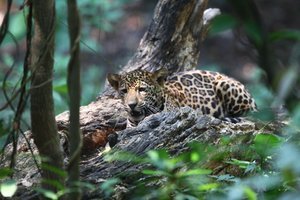
Picture the jaguar as both a guardian of its habitat and a symbol of biodiversity. Its presence reflects the health of the ecosystems it inhabits. It’s like the canary in the coal mine; if the jaguar is struggling, it’s a sign that other species and the environment are, too. In this article, we’ll break down the current status of jaguars, the challenges they face, and what’s being done to protect them. From habitat destruction to illegal hunting, the threats are significant, but there’s hope in the conservation efforts being crafted around the globe.
The Current Status of Jaguars
The International Union for Conservation of Nature (IUCN) classifies the jaguar as “Near Threatened.” This means it’s not yet endangered, but it’s on the cusp, with a declining population trend. In simple terms, the jaguar is like a tightrope walker; it’s managing to stay balanced, but one misstep could send it plummeting into a more dangerous category.
As of recent estimates, there are around 15,000 to 50,000 jaguars left in the wild. Most of these populations are concentrated in Central and South America. However, many of these populations are fragmented, which means that groups of jaguars are isolated from one another. This isolation can lead to inbreeding, reducing genetic diversity and making the species more vulnerable to disease and changing environmental conditions. Knowing this, you might wonder, “How did we get here?”
Threats Facing Jaguars
Jaguars face several substantial threats that contribute to their declining numbers. The most pressing of these is habitat loss, largely driven by deforestation for agriculture and urban development. Imagine a place that was once a thriving jungle, full of sounds and life, now reduced to bare land and scattered trees. This not only displaces the jaguar but also strips its food sources away, creating a double whammy for their survival.
Another significant threat is poaching. Jaguars are hunted for their beautiful fur, as well as for other body parts sold in illegal wildlife markets. This illegal trade is often driven by demand in countries where traditional medicines or status symbols are sought. The sad irony is that while jaguars are killing machines in their natural settings, humans are becoming the apex predators that threaten their existence.
Conservation Efforts in Action
While the situation looks grim, numerous conservation efforts are underway to protect jaguars. Organizations, governments, and local communities are banding together in this fight. One compelling approach is the establishment of wildlife corridors. These are like bridges that connect fragmented habitats, allowing jaguars to roam freely and find mates. It’s similar to constructing a highway where once there was only a dirt path. It not only benefits jaguars but also other wildlife in the region.
Another essential strategy involves community engagement. Local communities often hold the key to jaguar conservation. By providing education and resources, organizations help people understand the importance of preserving jaguars and their habitats. Imagine a group of kids in a small village learning about their local jaguar population and devising ways to coexist with these amazing animals. Empowering communities to be stewards of their environment can lead to significant positive changes.
What You Can Do to Help
Wondering how you can pitch in to save the jaguar? There are a few things you can do. First, consider supporting organizations focused on wildlife conservation. Many have initiatives specifically targeting jaguars, and a simple donation or volunteering your time can make a significant difference.
You can also spread awareness about the plight of jaguars. Sharing articles, social media posts, or hosting local awareness events helps raise consciousness around this issue. The more people know about the challenges jaguars face, the stronger the movement grows to protect them. Remember, every voice counts.
The Role of Zoos and Sanctuaries
Zoos and wildlife sanctuaries play a crucial role in jaguar conservation efforts. These facilities not only provide a safe haven for injured or orphaned jaguars but also contribute to breeding programs aimed at increasing the population. Think of these facilities as lifeboats in a stormy sea—they help ensure that these majestic creatures don’t go extinct while giving them a chance to thrive.
Moreover, zoos often participate in research efforts to learn more about jaguar behavior, genetics, and health. This information can be vital when devising conservation strategies in the wild. Educational programs offered by these institutions can also help raise awareness about the importance of protecting jaguars and their habitats.
The path to saving the jaguar is not an easy one, and challenges remain significant. However, there’s a collective passion for conservation that is igniting change. From habitat restoration to community involvement, every effort counts in the battle to save this iconic big cat.
As you reflect on the jaguar’s future, remember that you can contribute to its survival. Awareness, advocacy, and action can create positive ripples that extend far beyond your immediate circle. Let’s ensure that future generations will also have the chance to marvel at this magnificent creature in the wild. Because when one species thrives, we all benefit from the rich tapestry of life on our planet. The jaguar serves as a reminder of our connection to the natural world and the importance of preserving it.
